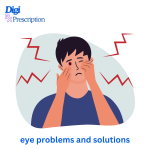
Our eyes are one of the most vital organs, allowing us to see and experience the world around us. However, various eye problems can affect our vision, leading to discomfort, blurred sight, or even serious complications. Understanding these issues and their solutions can help protect your eye health and maintain clear vision.
In this blog post, we’ll explore the most common eye problems, their symptoms, causes, and effective solutions.
1. Refractive Errors (Blurred Vision)
What is it?
The most common types include:
-
Myopia (Nearsightedness): Difficulty seeing distant objects.
-
Hyperopia (Farsightedness): Difficulty seeing close objects.
-
Astigmatism: Blurred or distorted vision at all distances.
-
Presbyopia: Age-related difficulty in seeing close objects.
Symptoms:
✔ Blurred vision
✔ Eye strain or headaches
✔ Difficulty reading or seeing at night
Solutions:
✔ Prescription Glasses or Contact Lenses: Correct vision by adjusting how light enters the eye.
✔ Laser Eye Surgery (LASIK): Permanent correction for refractive errors.
✔ Proper Lighting: Reduce strain while reading or working on screens.
2. Dry Eye Syndrome
What is it?
Dry eye occurs when the eyes don’t produce enough tears or when the tears evaporate too quickly. This can cause irritation, discomfort, and vision problems.
Symptoms:
✔ Redness and irritation
✔ A gritty or burning sensation
✔ Sensitivity to light
✔ Blurry vision
Solutions:
✔ Use Artificial Tears: Lubricating eye drops help maintain moisture.
✔ Blink More Often: Especially when using screens for long periods.
✔ Use a Humidifier: Adds moisture to the air and prevents tear evaporation.
3. Eye Strain (Digital Eye Strain or Computer Vision Syndrome)
What is it?
Prolonged screen use can cause eye fatigue, discomfort, and vision problems.
Symptoms:
✔ Tired, achy eyes
✔ Headaches
✔ Blurred or double vision
✔ Difficulty concentrating
Solutions:
✔ Use Blue Light Filters: Reduce strain from digital screens.
✔ Adjust Screen Brightness: Match your screen brightness to your surroundings.
✔ Wear Anti-Glare Glasses: Help reduce strain from screens.
4. Cataracts
What is it?
Cataracts cause the lens of the eye to become cloudy, leading to vision loss, especially in older adults.
Symptoms:
✔ Blurred or foggy vision
✔ Sensitivity to light
✔ Difficulty seeing at night
✔ Fading colors
Solutions:
✔ Wear Sunglasses: Protect your eyes from UV rays to slow cataract development.
✔ Eat a Healthy Diet: Antioxidant-rich foods (carrots, spinach, fish) support eye health.
✔ Cataract Surgery: The only permanent solution to restore clear vision.
5. Glaucoma
What is it?
Glaucoma is an eye condition that damages the optic nerve due to increased eye pressure, which can lead to blindness if untreated.
Symptoms:
✔ Gradual vision loss
✔ Tunnel vision (in later stages)
✔ Eye pain or headache
✔ Seeing halos around lights
Solutions:
✔ Regular Eye Exams: Early detection is key to preventing vision loss.
✔ Use Prescription Eye Drops: Reduce eye pressure to prevent damage.
✔ Surgery or Laser Treatment: Helps control eye pressure when medications aren’t enough.
6. Conjunctivitis (Pink Eye)
What is it?
Pink eye is an infection or inflammation of the conjunctiva (the clear tissue covering the white part of the eye). It can be caused by bacteria, viruses, or allergies.
Symptoms:
✔ Redness and swelling
✔ Itchy, watery eyes
✔ Sticky discharge (especially in bacterial conjunctivitis)
Solutions:
✔ Maintain Good Hygiene: Wash hands often and avoid touching your eyes.
✔ Use Antibiotic Drops (for Bacterial Pink Eye): Only if prescribed by a doctor.
✔ Cold or Warm Compresses: Helps soothe irritation.
✔ Avoid Allergens: If caused by allergies, avoid triggers like dust or pollen.
7. Macular Degeneration
What is it?
Age-related macular degeneration (AMD) affects the central part of the retina, leading to vision loss in older adults.
Symptoms:
✔ Blurred or distorted central vision
✔ Difficulty reading or recognizing faces
✔ Dark spots in vision
Solutions:
✔ Eat Leafy Greens & Fish: Omega-3 and lutein-rich foods help slow progression.
✔ Quit Smoking: Smoking increases the risk of macular degeneration.
✔ Regular Eye Exams: Early detection can slow vision loss.
8. Diabetic Retinopathy
What is it?
Diabetes can damage blood vessels in the retina, leading to vision problems and potential blindness.
Symptoms:
✔ Blurred vision
✔ Dark spots or floaters
✔ Vision loss in advanced stages
Solutions:
✔ Control Blood Sugar Levels: Proper diabetes management prevents complications.
✔ Regular Eye Checkups: Early detection can prevent severe vision loss.
✔ Laser Treatment or Injections: Helps treat advanced stages.
9. Eye Allergies
What is it?
Eye allergies occur when allergens (pollen, dust, pet dander) cause eye irritation.
Symptoms:
✔ Itchy, red, watery eyes
✔ Swelling around the eyes
✔ Burning sensation
Solutions:
✔ Avoid Allergens: Stay indoors during high pollen counts.
✔ Use Antihistamine Eye Drops: Reduce allergy symptoms.
✔ Cold Compress: Soothes irritation and swelling.
Conclusion
Many eye problems can be prevented or managed with early detection and proper care. Regular eye exams, a healthy lifestyle, and protective measures like wearing sunglasses and taking screen breaks can significantly improve eye health. If you experience persistent eye discomfort or vision changes, consult an eye specialist immediately for a professional diagnosis and treatment.
References:
-
American Academy of Ophthalmology (AAO) – Eye Health Basics – https://www.aao.org
-
National Eye Institute (NEI) – Common Vision Problems – https://www.nei.nih.gov
-
Mayo Clinic – Eye Diseases and Conditions – https://www.mayoclinic.org
-
World Health Organization (WHO) – Global Eye Health Report – https://www.who.int
